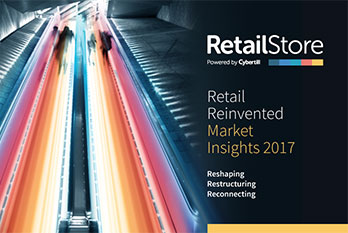How many of us can honestly say they haven’t ordered from Amazon, no matter how loyal we are to the local high street?
We just can’t stop ourselves on that handy app that’s always at our finger tips whether we are sat on the sofa, on the train, at dinner – or whilst walking around a shop looking for a specific item.
Not only is it incredibly competitive priced but offers just about everything we ever search and importantly, delivers convenience that is simply just too tempting no matter how loyal we are to our local shops and ‘Britishness’.
Backing this are figures from a recent survey by PwC which showed that 48% of those who shop online do so for convenience over cost.
And it’s just getting better, more disrupting and let’s be honest, a bit disturbing. Grocery deliveries on those inconvenient must-have house hold items in just an hour; talk of drone delivery; and now Echo voice shopping live and ready to go.
But will the lure of the in-store experience every really die? We think not.
The power of the in-store experience with its social, sensory and personal elements is unyielding, whatever online price wars are being fought. The blurring of channel boundaries has been further fuelled by click and collect; providing customers with the greater choice offered online together with the convenience of trying, feeling and buying in-store.
The introduction of the click and collect service has been hugely successful for many of the UK’s big retail brands, with 43% of consumers (and 52% of 21-35 year olds) agreeing that it means they now shop online.
With reverse services, such as in-store click and deliver bourgeoning as retailers seek to extend the highest level of convenience by allowing customers to experience and buy in-store and yet free them of the hassle of carrying it home, retail as a destination is a trend we are going to see strengthen.
The high street shop is certainly not dead and is a critical part of the shopping journey. Nearly half of consumers say they are more loyal to the brands they shop at in-store than they are online.
Pure e-commerce players are understanding more and more when it comes to satisfying customers, it all comes down to the fundamental need for help and exceptional experiences.
These traditional pure-play e-commerce retailers such as Missguided and Made.com are seizing and investing in this opportunity to provide ‘real world’ customer service by opening physical stores to enable the all-important ‘feel and experience’ part of the buying journey.
Recent figures released in the PwC Total Retail Report revealed that 75% of British consumers felt the most important element of the shopping experience was to have sales staff with good knowledge. They want and demand their help and must adapt to also include extended product aisles on screen in-store too as the survey showed how 68% consumers want this too. Events, personalised offers and ambience were also right up there with the demands of this new digitally savvy consumer.
In fact, traditional pure e-commerce players are transforming and remoulding how they sell and operate for competitive advantage much quicker than traditional in-store retailers.
The increasingly heightened consumer need for exceptional experiences is transforming many physical retailers and centres into destinations to attract the hospitality and leisure loving consumer of today by working together collaboratively for a collective experience.
Retail combined with leisure has the power to draw consumers in-store, even if they can buy items cheaper online. The success of Liverpool ONE is testament to this approach which blends everything from retail, hospitality, digital, convenience and experience, and nearly a decade since it opened its characteristics are being mirrored by individual retailers.
The Oasis relaunch of its flagship store on Tottenham Court Road, for example, tied the retail-hospitality knot more tightly, focusing on experience rather than produce with an in-house café-cum-cocktail bar and beauty salon, turning the retail experience into one of leisure.
7 Things to Consider to Increase In-Store Footfall
1. Become an expert
There’s nothing more compelling than someone who knows their stuff. Become the resident expert on your subject matter and customers will flock to you for advice. Make your retail environment one that showcases your superior expertise by using and differentiates you from your competitors. Suddenly, you become a retail destination because shoppers need you. How can your staff’s own mobile phone play a part in product knowledge?
2. Build an Experience in the Shop
Physical retail stores can no longer exist just to display products for sale. Instead, think of it as a showroom full of experiences that will draw customers in to get to know your brand better. Make them understand your brand better than they’d ever be able to do online.
It’s not about selling products, it’s about experiencing the brand. Surround your products in an experience that they’ll remember and share. What kind of unique experience would be relevant to your brand? (And don’t forget, even simple customer history prompts at the till PoS can make a massive difference!)
3. Going Beyond Product
Developing compelling reasons to visit your shop/s beyond product purchase to experience is a great plus. Learn from what’s worked for big brands over the years e.g. John Lewis’ fame for its restaurant and now it’s spa offering. What’s stopping high end brands such as Ted Baker introducing trendy champagne bars either through sponsorship or concessions, after all, how many people visit Selfridges to experience the champagne and sushi bars?
4. Link Your Online to Your Offline
Gone are the days when brick-and-mortar shops can stand alone, it’s the age of the multi-channel retail model. Make sure you have an e-commerce component to your offering, and make sure it is integrated in real time through a Cloud EPoS and retail management system to synchronise your physical and online presence, transactions and loyalty initiatives. Link the two to get your customers to cross-fertilise between offerings, creating a rich in-store experience and a fast, convenient responsive website that makes it easy for customers to use both in any given day.
5. The Mobile Link
It’s probably safe to say the opportunities for mobile are endless and no end to the possibilities. More than 38% of consumers in the PWC survey shopped online via their phones and Smartphones being used to make purchases rose by 5% in just the last year (now accounting for 17% of all transactions). For now, at least, if you have your online and in-store linked and your stock inventory as-one in the Cloud for retail visibility, then offering customers extended in-store choice, ‘infinite aisles’, pay and deliver options… and a lot more. You don’t have to go as far as in-store apps, augmented reality if you don’t want to; extended product choice, availability, delivery and e-receipts are already easy mobile engagement and experience tools. It’s no longer just about mobile PoS, it’s about a whole lot more!
6. Loyalty Matters
Everyone loves to feel valued and brand loyalty is something us shoppers find far easier with bricks and mortar brands than online brands. Improving customer loyalty programs and using central customer data to personalise incentives is going to be a deciding factoring in winning and keeping your customers loving you. Personalisation, successful omni-channel experience and your familiarity with your valued customers across any outlet is going to be your winning Ace whatever size or shape you are.
7. The Partner Approach
No matter how big or small a name you are, cross-sector strategic partnerships may be able to help you introduce new experiences and help create your retail space as a local destination. For example, if you are a local florist, could you team up with a local bakery or coffee shop to offer an area of space in your shop as a ‘garden café where customers can experience the flowers, tea and smells – and then either purchase some flowers there and then or order digitally some of the displays they can see?
What could you be doing better to excel in the in-store experience phenomena to beat of the online competition?
Why not download the lasted retail research report: “Retail Reinvented: Market Insights 2017”?

Extensive UK retail market research into the trends, opinions and facts on the changing retailing landscape, multi-channel demands, omni-channel experiences, click and collect fulfillment, cloud epos and retail management software

Rachel is passionate about retail and the ever-changing retail technology environment, with a keen eye for upcoming retail trends that are set to shake up the sector.

